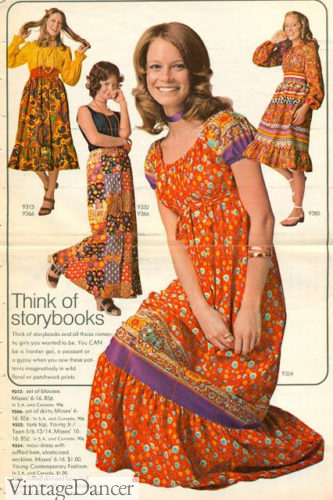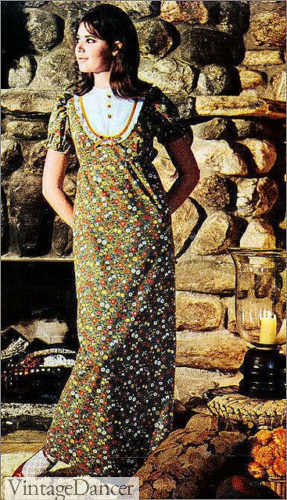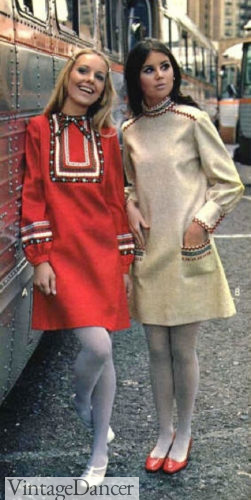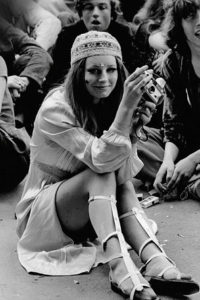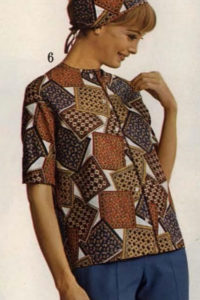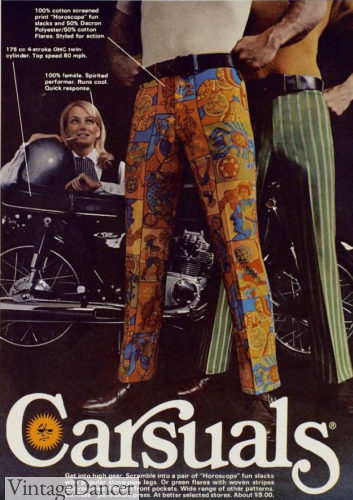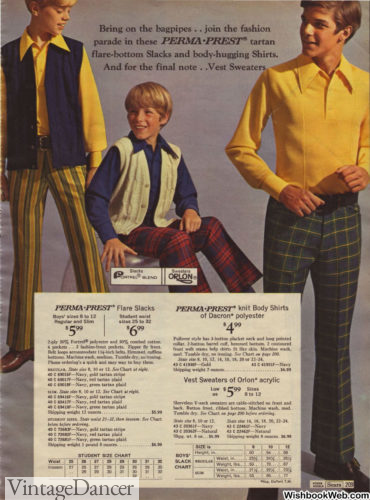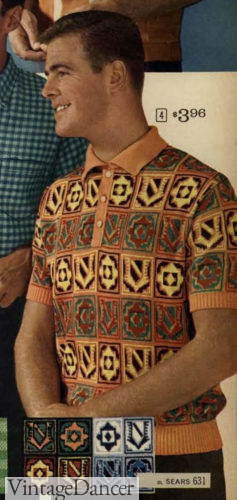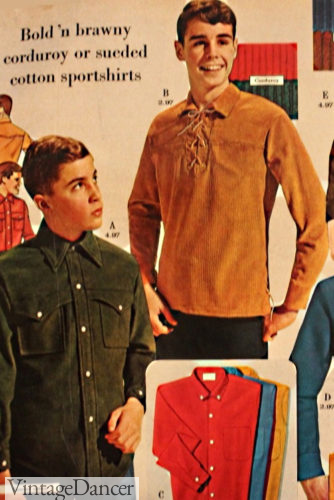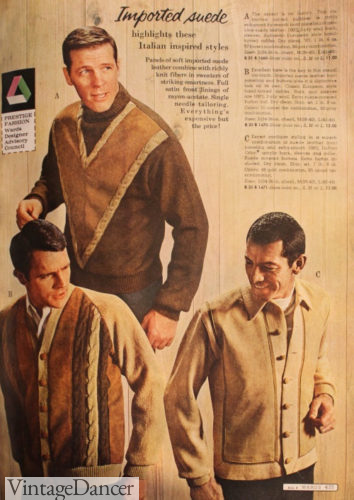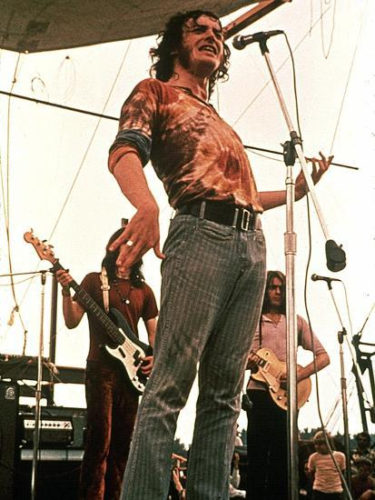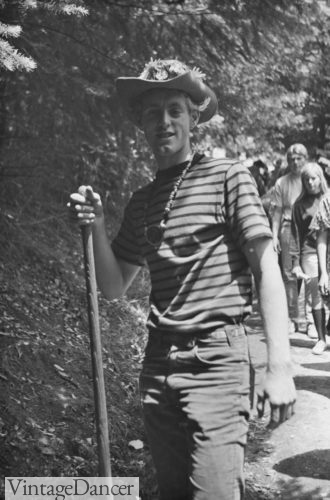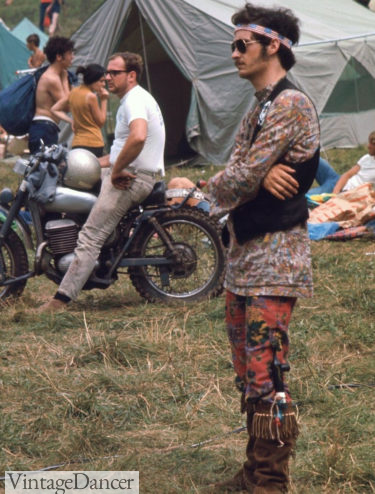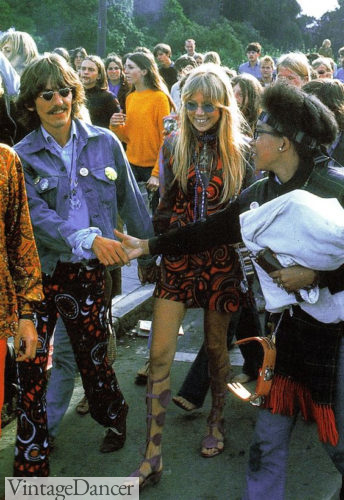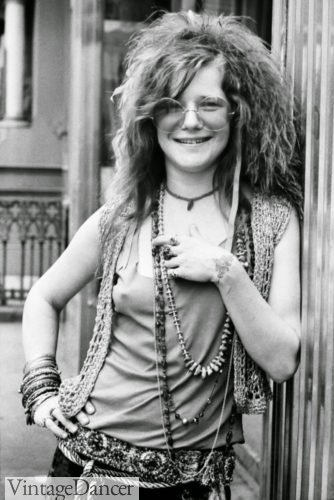
Janis Joplin remains a major inspiration for hippie and bohemian fashion even today.
60s Hippie Fashion part 2. Now that you know the basics of what went into hippies and their clothing, let’s look for some hippie outfits to recreate, for women and men. First up, the women hippies.
60s Hippie Fashion Tips
Scroll down or click the following links to jump to women’s hippie fashion or men’s hippie fashion.
What hippies wore was an act of protest against their society. Their old and ill-fitting clothes rejected the growing emphasis on consumerism and trend-following in mid-’60s culture.
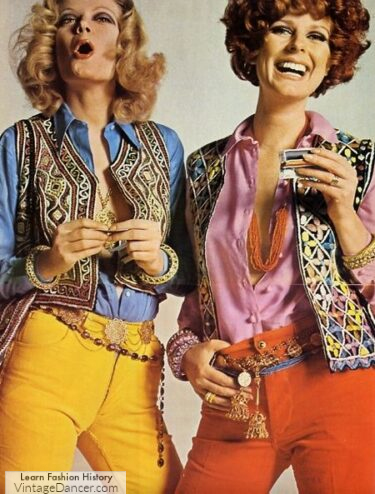
1960s hippie outfits
Countering the “mod” preference of sleek and tight, hippie silhouettes were loose, unstructured, and topheavy. Even mod materialism was turned on its head — designer clothes did not make the hippie who he was, but instead the hippie made his clothes reflect himself.
Articles of clothing could be hand-personalized through acid washing, tie dyeing, painting, pins, studs, beading, patches, and embroidery.
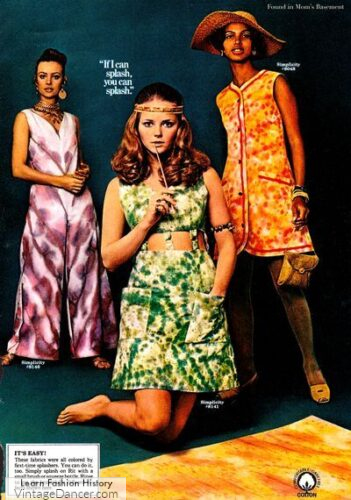
Tie Dye hippie dresses
Today, it is just as easy to purchase clothes with the “work” done for you, but nothing can replace getting your own hands dirty. Perfection was never the goal. Disruption was.
Accessorizing is key to an accurate 1960s hippie outfit. Bandannas, scarves, and jewelry were all very common for both women and men.
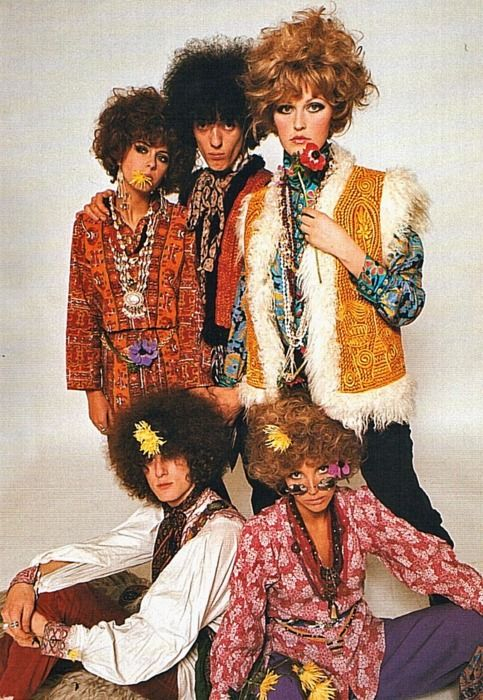
’60s fashion and accessories. Silhouettes were androgynous — there are two men in there.
Necklaces and bracelets were worn by the dozen and made of leather, hemp, or straw. They could be beaded (donkey beads were particularly popular) or wrapped in fabric. Rings and wider bangle bracelets were popular, and these, too, could be worn to excess. Jewelry among hippies was not regarded for its quality or status, and cheap costume jewelry was preferable for its price point.
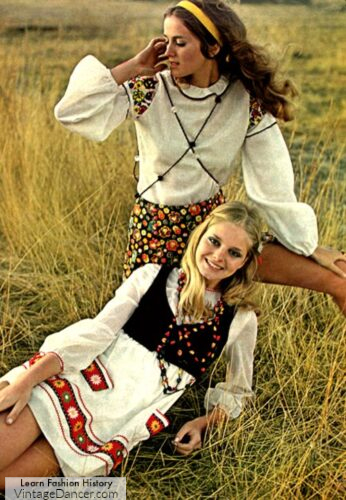
Hats, when worn, followed no rhyme or reason: while women often sought the most gigantic and floppiest floppy hat, men could be seen wearing decorated cowboy hats, bucket hats, top hats, and even women’s cloches. Belts for both sexes were either a thin strip of cloth or thick and detailed with a large belt buckle.
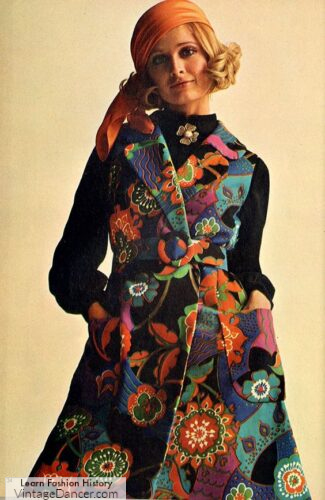
1969 Vogue hippie coat and headscarf
Sunglasses were primarily either round or oversized plastic frames, with other novelty shapes such as hearts or squares appearing more often on performers than hippies themselves. Into the 70s, sunglasses became oversized statements.
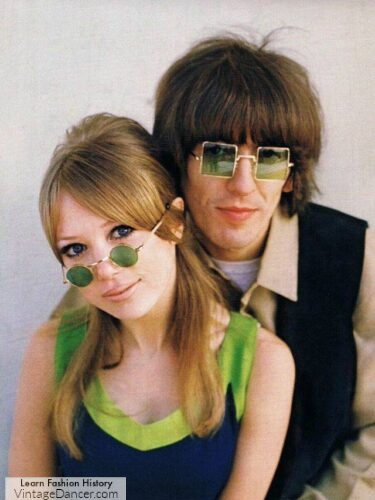
Pattie Boyd and George Harrison colored sunglasses
Gradient lenses hit the mainstream in the mid-’60s and grew to dominate sunglasses in the later years, however hippies did not typically wear them until the early ’70s. Instead, round frames tinted with a pastel color became the fad in hippie circles.
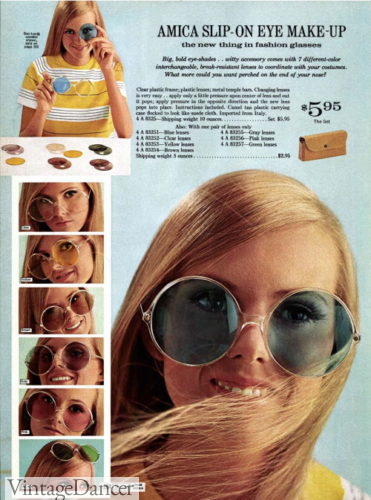
1969 hippie oversized glasses
These rounds could be standard or oversized and were most popular in pink, purple, blue, and yellow.
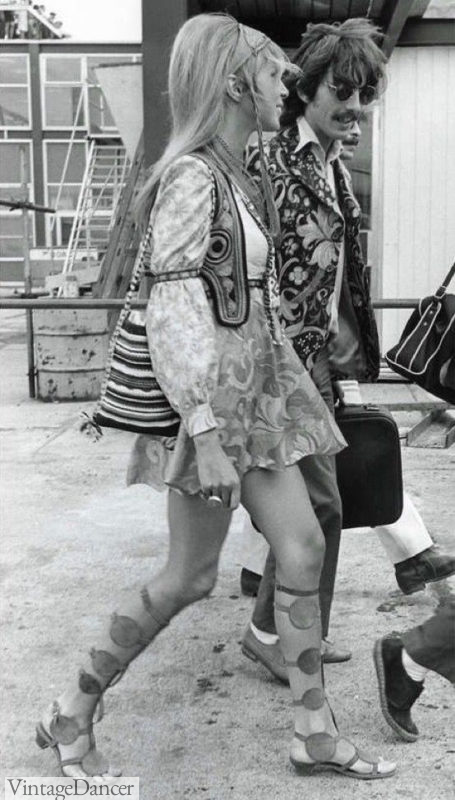
1967 Pattie Boyd wears a paisley mini dress, ethnic beaded vest, gladiator sandals and handmade headband/armsbands/belt
Shoes were optional, but when worn, basic styles dominated – boots and sandals were most common, with brown being the preferred color.
Patty Boyd and other musicians wore Gladiator sandals and other fully lace up sandals with short peasant dresses.
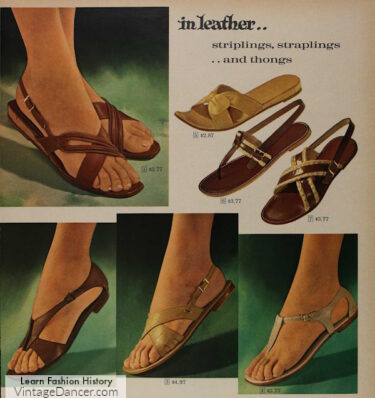
1966 leather sandals, perfect for earthy hippies
Simple lace-up canvas shoes did well enough for most seeking comfortable and cheap footwear.
As “trendier” hippies joined in the later years, mainstream shoes such as go-go boots, winklepickers, and chukka boots bled into hippie fashion. This was an extension of mod fashion.
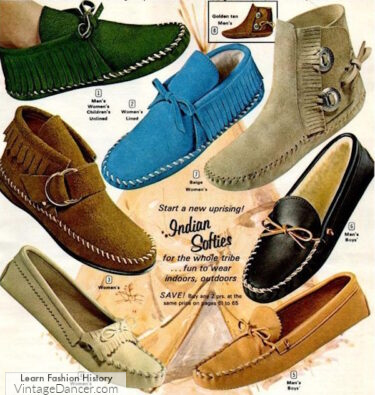
1969 moccasin shoes and boots,
Towards the end of the decade the move to more earthy shoes made in suede or rough leather were inspired by hippies. Moccasins with Native American influences were ideal hippie shoes. Loafers, slip-on casual shoes, half booties, and monk straps were all given a natural look.
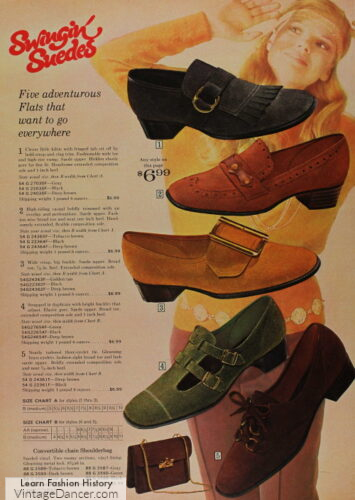
1969 suede shoes
‘60s Hippie Fashion for Women
Mounting feminist attitudes and the “free love” mindset within hippie culture led to a spike in androgyny and rule-bending. Hippie women could and often did wear men’s clothing.
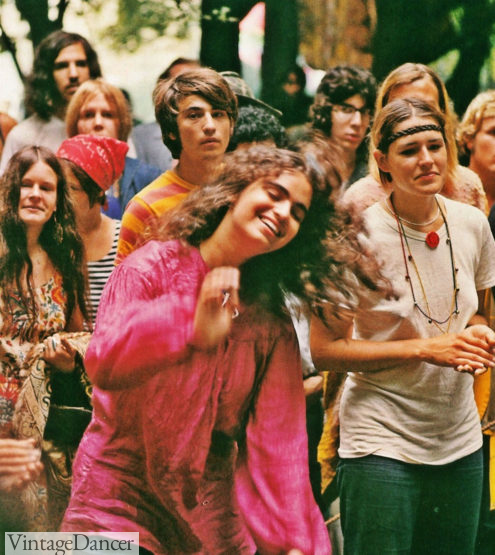
A group of hippie women showing various hippie styles at Woodstock 1969
Men’s tee shirts and pants were comfortable, and oversized men’s jackets and workshirts were easily appropriated into minidresses.
Makeup was rare, bras were optional, and grooming was minimal. Towards the later ’60s, women wore their shirts tied up or cut short to expose their midriffs. Among hippies, it was an era of “anything goes.”
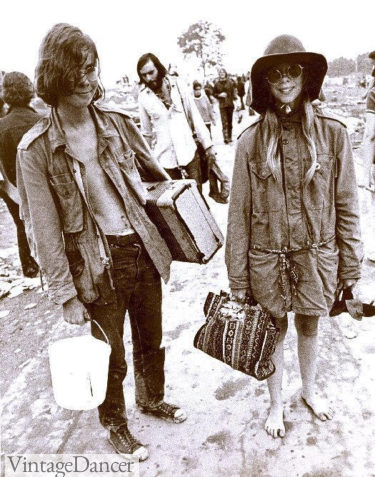
A young hippie couple at the 1969 Woodstock Festival. Both wear a men’s military jacket in different ways.
On the more feminine side, women’s hippie fashion brought back smocked maxi length dresses, A-line skirts, and wide-leg beach pants. Made of light fabrics such as cotton or linen, these were typically either bright solids or ethnic prints.
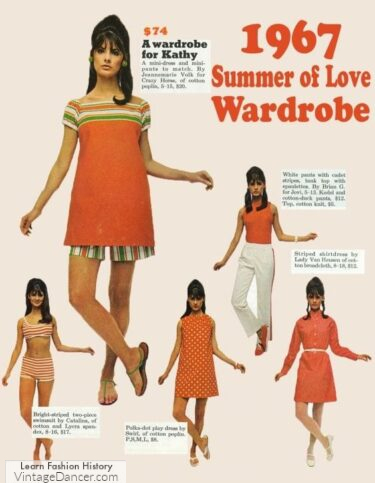
1967 Summer of Love outfit ideas
Clean, modest column-shaped dresses from the early 20th century were bought from antique stores and worn without regard for the tighter, shorter ’60s silhouette.
On the dresses, bishop sleeves and exaggerated bell sleeves kept with the hippy-dippy trend of loose and flowing fabric. So did peasant blouses, kimono shawls, ponchos, and screen-printed scarves, with the added benefit of more versatility than dresses.
- Smocked peasant dresses and patchwork skirts
- 1965 Gunnie Sax prairie dress
Among hippie women emerged a new style that had its roots in activism, back-to-nature movements, and yoga. Adding a touch of Americana to the diverse pool of hippie fashion influence, this was the “Earth Mother” look.
- 1967 peasant style hippie dress
- 1967 ethnic embroidery tunic dresses
Long unstyled hair held back with a headpiece, natural faces, and floating silhouettes made for a look that was peaceful, friendly, and almost mythical.
Clean whites and rich earthy tones in both solids and a variety of patterns broke through the psychedelic colors of hippie clothing and founded early bohemian, or boho, fashion. From this, too, came the act of “upcycling” old cloth into new outfits.
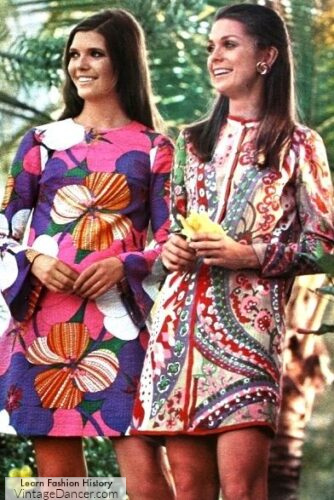
bold prints for modern hippies
Creative and environmentally conscious hippie women used what was available to make their clothing. Patchwork shirts, jackets, and skirts were stitched together from scraps, and even dresses could be made out of anything — including bedsheets.
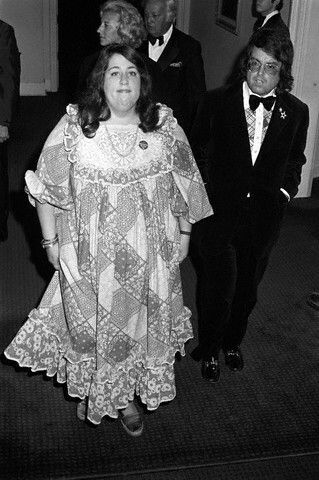
1960s patchwork dress (Mama Cass)
What wasn’t made new was often treated with the “never say die” mindset and sewn, patched, and repaired into immortality.
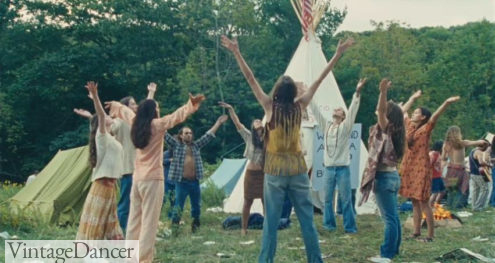
1969 Hippies performing a Rain Dance – note the seemingly handmade poncho on the center-right woman and the outfit of the woman on the far left.
Even among accessories, ingenuity was found. Beads, seeds, feathers, and small strips of cloth were easily worked into hair or strung onto necklaces as decoration. Flower garlands were excellent on-the-spot headpieces. There was a beauty in nature, and anything could find a new purpose.
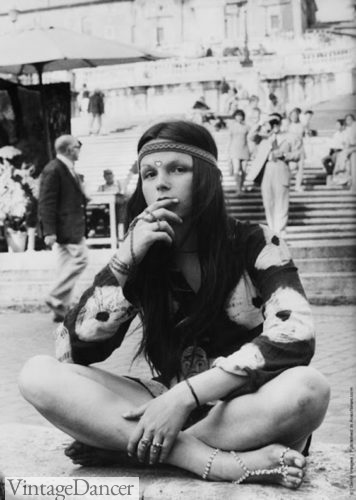
Long hair with a headband was a signature look for hippies in the ’60s and ’70s.
Since the ’60s fashion scene wasn’t quite “with it,” ingenuity was the key to achieving most hippie women’s looks. To get what she wanted, she was typically left to make it herself, and the imperfections and eccentricity of that handmade clothing grew to become the appeal.
- 1968 clean white dress with bishop sleeves.
- 1965 a patchwork printed shirt and headscarf
Uneven sleeves and odd shapes, such as the frock with bell sleeves, became iconic within hippie women’s fashion. Many clothes went through a “rite of passage” where they were, in some way, customized and given character before they saw regular use.
- 1967 Pattie Boyd-Harrison
- Pattie Boyd-Harrison ethnic print dress, purple gladiator sandals
For those who didn’t want to wear ethnic prints, clothing was just as commonly bleached or dyed into either a solid color, a textured solid, or tie-dye. Warmer colors such as pink, violet, mustard, and orange, and brown were favored within hippie women’s clothing.
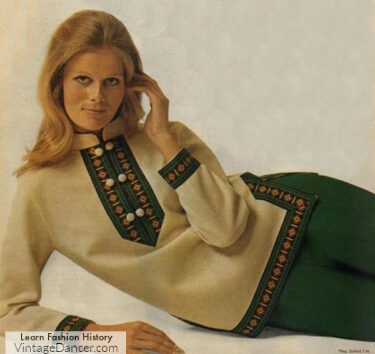
1968 ethnic style top
Acid-washed (muted) solids, stripes, tie-dye, and assorted ethnic/Americana prints were the primary patterns.
At the height of the hippie organics craze, synthetic fabrics were rarely found on a 1960s hippie woman unless she was more fashion forward. This did change in the 1970s, however, as hippie fashion hit stores full-force.
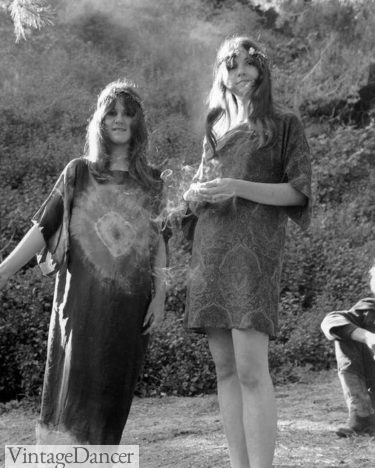
(1967) Relaxed hippie frocks with tie dye patterns were a comfortable and easy look for hippie women.
Unlike men’s clothing, stylistically distinct and unusual women’s hippie outfits were relatively common. Pirate, fairy/fae, and Renaissance elements were transferred into a hippie style that often had more appeal than simple hippie women’s outfits.
Granted, those “simple” looks were also about the same as men’s — an optional tee shirt/sweater with a pair of pants, or a ’60s cut dress — and even those plainly dressed hippie women accessorized their simple outfits to fit the hippie style.
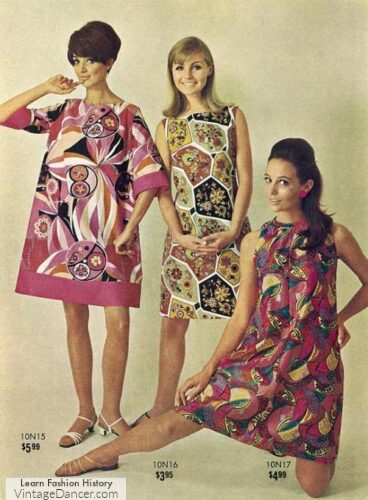
Bold print dresses were layered with accessories
Headbands and bracelets in particular seemed like a uniform.
The downright outrageous costumes, however, were still rather uncommon. They usually involved beyond-excessive amounts of beading, fringe, political statement pieces, or heavy and ornate decorations.
If she was with a friend or partner, they may have coordinated looks with a matching pattern or theme.
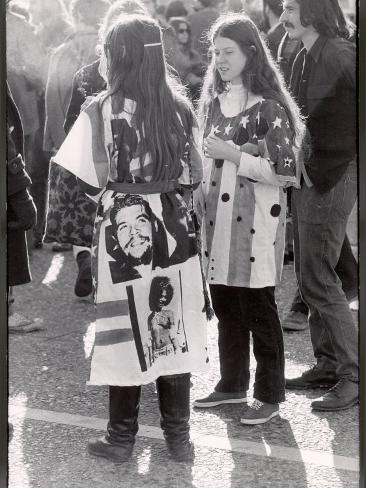
Two hippie women wearing dresses with the American flag and Che Guevara in 1968.
Casual, more style-conscious hippie women could be found in minidresses, beach rompers, and loose blouses with corduroy shorts. These often left a sleeker silhouette that was loosened up with bead necklaces and a shawl or large scarf draped over the shoulders.
Shorter dress cuts with vibrant hippie-inspired colors hit department stores with great success, as did bohemian headbands and scarves.
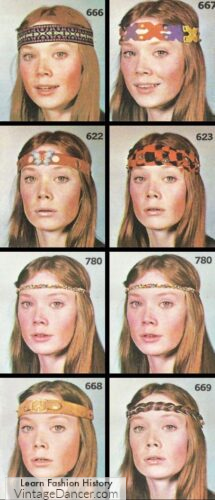
1960s hippie headbands
Acid-washed denim, a rising trend among hippie jeans, led to denim manufacturers offering both jeans and jackets pre-washed on the shelves.
By the early ’70s, clothing designers had established fringe jackets, coveralls, and embroidered denim as women’s styles.
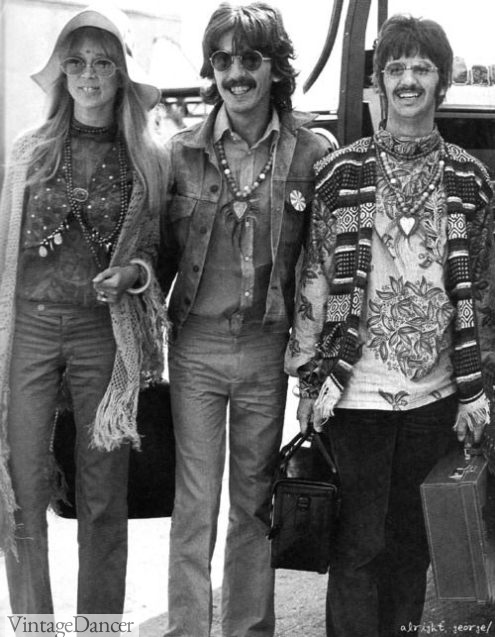
Classic ’60s style with Pattie Boyd, George Harrison, and Ringo Starr wearing jeans or cords with ethnic shirts, crochet and fringe vests, bead necklaces, and round sunglasses.
Your 60s Hippie Outfit
When developing a hippie outfit, it’s important to consider the when. Basic clothes with a more masculine silhouette, like a pair of pants and a cable knit sweater, work well for an early hippie outfit. All it takes is a bandanna and some daisy flowers for the student protester look.
To keep with the same clothes in 1969, however, the sweater would have to be oversized and the pants flared or nonexistent. Additional necklaces, a hat, and perhaps a decorated scarf or wrap would be ideal for accessories in the later years.
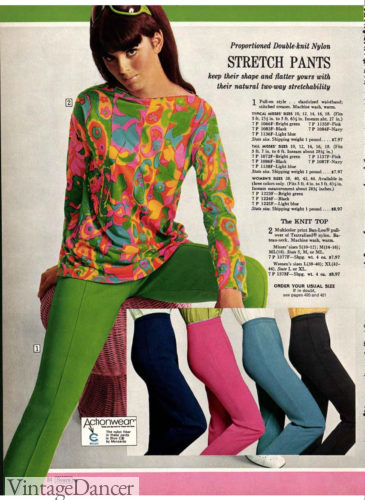
1968, trippy colors and pattern were mainstream and worn by some festival goers although not “hippie” enough for the more dedicated hippies
“Disco hippies” with psychedelic minidresses, bell sleeves, and go-go boots did exist, but not to the extent Halloween costume makers imply. It was unlikely to be seen within the hippie movement, but rather served as a hippie inspired outfit in mod or disco style.
Since these trippy colors and patterns were in the mainstream around 1966-1968 some festival goers were wearing them, mixing them with other less trendy accessories.
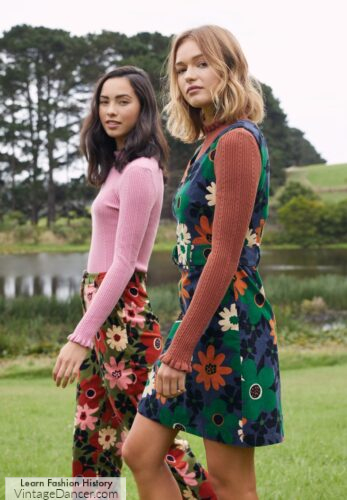
Princess Highway Australian brand features flower prints and 60s cuts. Shop them in the USA at Modcloth.
How “hippie” vs mainstream a girl dressed was entirely dependent on her dedication to the movement, the style, creativity, and her budget.
Similarly, long and flowing white hippie dresses weren’t worn to a notable degree prior t0 1967, and saw far more popularity in the late 1970s.
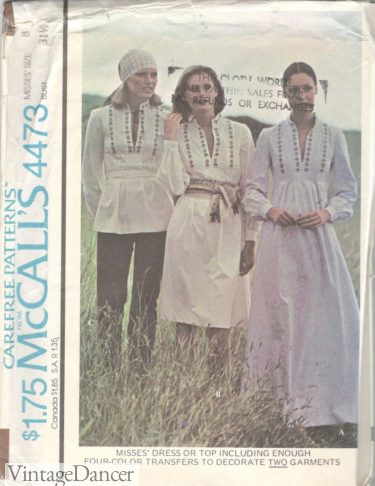
1970s McCall’s pattern for a very hippie inspired peasant top or dress.
It’s in the details – some notes on styling:
- In 1967, short tunic dresses with ethnic prints, paisley, swirls, and flowers in “psychedelic” colors kicked off the festival season. Pair one of these with a natural colored vest, beads, belt, sandals, and a headband for a mixed media look. Save Renaissance inspired or peasant dresses in colorful prints for later ’60s hippie style.
- Accessories are crucial. A headband of daisy flowers, braided leather, or beaded patterns should be the absolute minimum worn. Bandannas and headscarves or floppy hats protected heads from the hot sun, and round sunglasses were the most iconic ’60s hippie eyewear. Bracelets and necklaces can and should be worn excessively, outfit allowing.
- Most blue jeans in the ’60s were straight leg and high waisted. There were only a few flared leg jeans with a low waist, often tie-dyed or acid washed for personality. Keep these (and flares in general) to the later years.
- You can add texture to an untextured shirt, dress, or pair of pants by crumpling it up, lightly misting it with water, and letting it dry before wearing it. Sometimes, this is all it takes to add a more bohemian look to a piece.
- Heels weren’t practical enough to have much of an effect on hippie fashion. Stick to something you can hike through mud in – flat sandals, tall boots, barefoot.
- While hippies were not afraid to show skin, it was the ‘60s, V-necks and scoop necks were high enough not to show cleavage, and sleeveless shirts had a wider (about 2-inch) shoulder.
- Hotpants (shorts) were usually cut with a flare and had an inseam no shorter than 3”. Deviating from this occurred, but required scissors and dedication.
‘60s Hippie Clothing Tips for Men
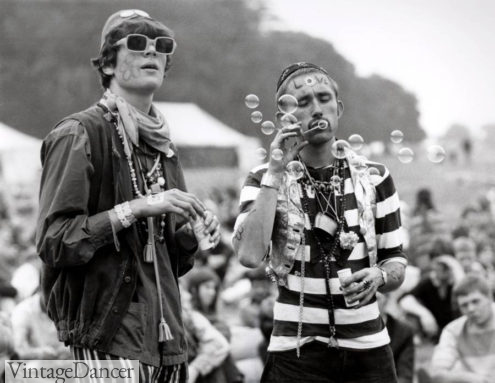
Two hippie men blowing bubbles at the 1967 Festival of the Flower Children in England
Men’s hippie fashion ranged from basic to outrageous, but extremely simple looks were the most prevalent.
For most hippies, a shirt (optional) and casual pants were the uniform.
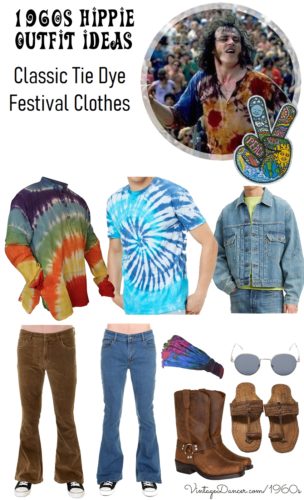
Classic hippie outfits. See more ideas here.
Beatlemania kept turtlenecks relevant, but tee shirts were more comfortable, cool, and inexpensive. When it came to trousers, slim-straight cuts in corduroy, cotton pique, and denim were accessible staple pieces.
Pants rises ranged from high (at the belly button) to “low” (~2” below the belly button).
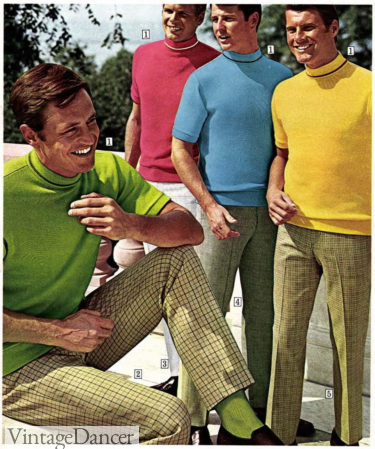
1969 – Parts of mod men’s style were occasionally worn by hippies.
As psychedelic hues grew more accessible, pants in saturated solid colors gained traction on the men’s side. These were seen primarily in a slim or wide straight leg, with a few flared options.
Unlike the pattern-heavy pants of ’60s mod fashion, hippie men opted primarily for pants in solids, stencilwork, or vertical stripes until the early 1970s.
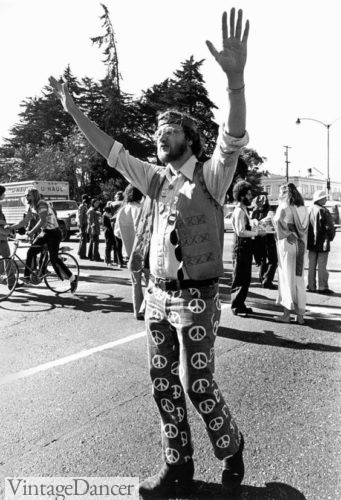
Peace sign jeans.
Instead, patterns in hippie men’s fashion showed through button ups with ornate patterns. Busy prints in an array of vibrant colors were easy for hippie men to find by 1967, and they were worn throughout the movement.
While paisleys are the most memorable to date, there were also geometric shapes, florals, textured solids, and abstract organic patterns.
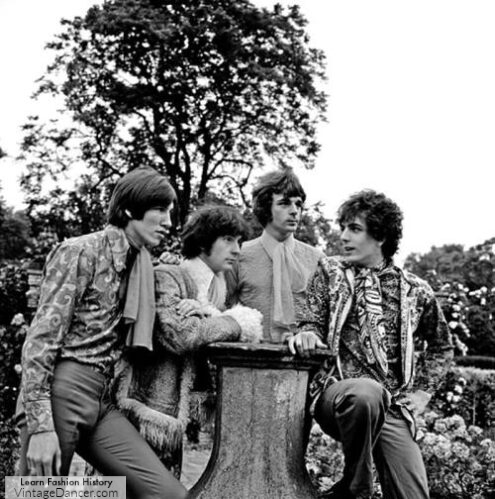
Pink Floyd in Ruskin Park, London, April 1967
These kaleidoscopic patterns with big ’60s collars made a statement. Paired with a pair of saturated solid-colored trousers in a rich maroon or electric blue, it was a staple look of the late ’60s rock scene as well.
- Horoscope pants
- 1969 plaids and stripes flared pants
While it wasn’t overly common, robes and tunics were seen more on hippie men than women. Draped in a richly printed tunic and cape with his hair grown long, a hippie could look almost like a messiah – and that was often the point.
Spiritually-inspired clothing to any degree served as an homage to the religious experiences hippies would feel through drug use, or it was worn as a nod towards their own enlightenment.
Afghans, capes, and shawls also provided unrestricted movement with less spirituality.
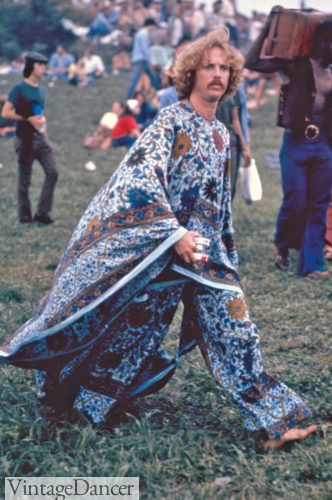
A “way out” hippie man wears dons his robes to the Woodstock Festival. Note the men’s outfits in the background.
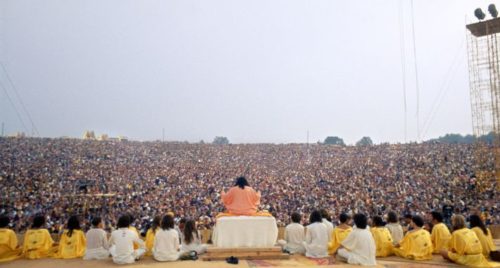
“The Woodstock Guru” Satchidananda Saraswati leads a prayer of peace and love to kick off the music festival.
On the broader scale, Eastern fashion became explosively popular in the later 1960s. Asian influence was found in men’s tunic shirts, vests, sandals, slippers, and their selection of jewelry embellishments.
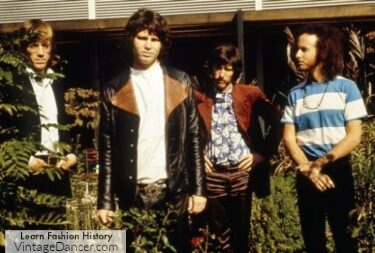
The Doors
Beaded necklaces, headbands, and bracelets were seen just as often on men as they were on women. Clothing prints, designs, and even fabrics took heavy inspiration from India in particular.
Baja hoodies (also known as drug rugs) were a result of Latin American and surfer influence — contrary to popular belief, they were not popular with hippies in the ’60s.
- 1962 Ethnic Print Polo Shirt
- 1967 Lace-Up “Renaissance” Shirts
Perhaps more important than any other influence of men’s hippie fashion was the rugged and durable clothing from military, workwear, and biker influences.
It was there in the beginning of the movement, and saw it to its end. Leather jackets, particularly the A-2 bomber jacket, were a staple piece of outerwear in the earlier years, worn over turtlenecks and mohair sweaters.
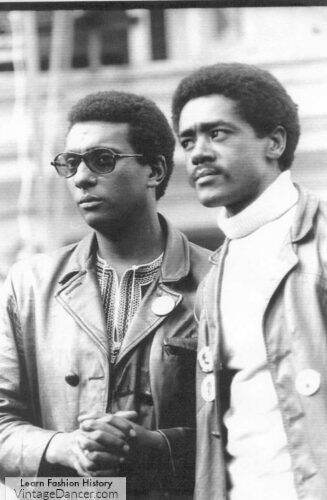
Newer jackets such as the fringe or utility jacket never grew quite as popular as they did for women, but denim jackets, field jackets, and leather vests filled the niche of heavy outerwear when the A-2 lost popularity in the late 1960s.
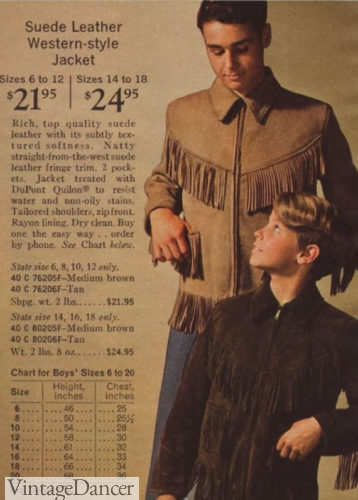
1969 fringe suede jackets
Mechanic’s coveralls were a quick and easy way to stand out, with the added bonus of being blank canvases for customization and rather taboo as a fashion choice.
Western shirts, plaids, and work shirts were cheap to find and could serve as both base layers and second layers among 1960s hippies seeking something loose and comfortable.
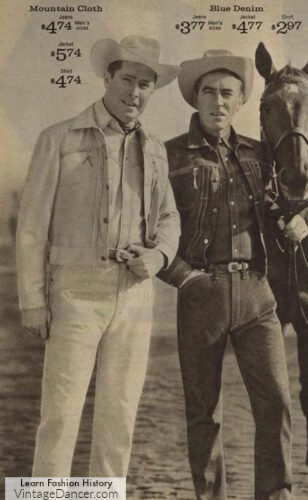
1961 westernwear was easily transformed into hippie clothes
At the time, blue-collar workshirts were notoriously baggy and oversized compared to the more slim-cut shirts of the fashion scene, so they fit well with the loose silhouettes hippies preferred.
In addition to being soft and comfortable, henley shirts, both long sleeve and short sleeve, took to dyeing well and were light enough to wear in any weather. Work boots, particularly cowboy boots and harness boots, were most popular in brown.
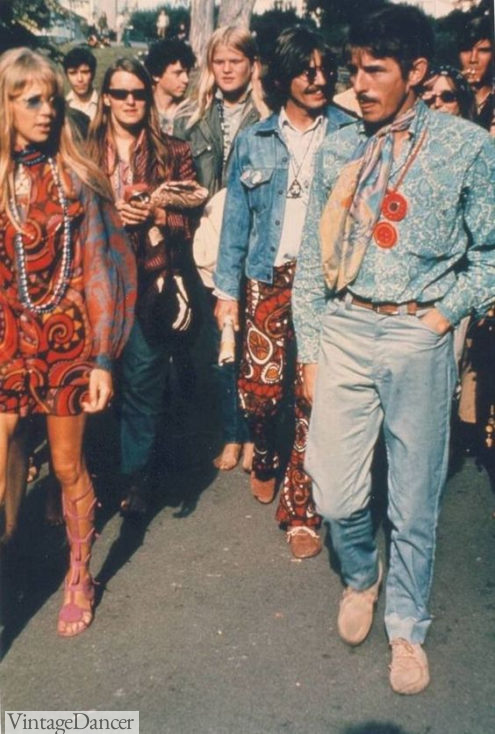
Pattie Boyd and George Harrison in San Francisco
When it wasn’t simple, men’s hippie fashion was one of many layers. Shirts, vests, second layers, and jackets appeared in countless variations.
Owing to this capacity for layering, a popular look emerged from men simply doing without any base layer. Vests, jackets, and coveralls could be worn with no shirt underneath them. Workshirts could be unbuttoned with the hem tucked or untucked.
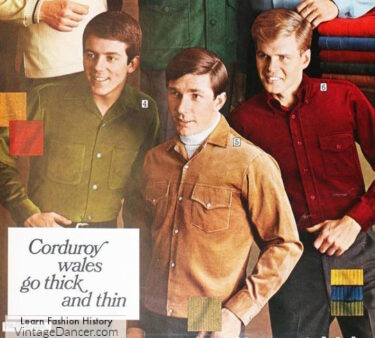
Men’s work shirts
The main colors seen on hippie men were purple, blue, maroon, orange, and green. Patterns could be solids, textured solids, tie dyes, or ethnic prints. Stencils and paint were a hippie man’s default when he wanted to customize his clothing.
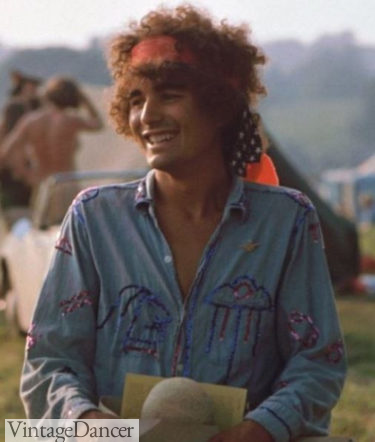
A young hippie man with his hair tied back wearing a hand-decorated chambray workshirt.
Compared to women’s hippie fashion, men’s hippie fashion had the potential to be far more chaotic. Elements from military, pirate, dandy, Western, circus, and countless other styles were taken and adapted into a style which sometimes had all elements in one outfit.
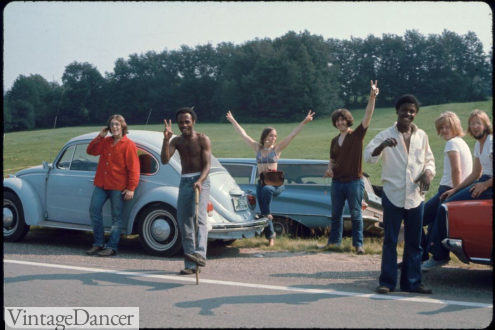
Peace signs and VW Beetles abound at Woodstock 1969.
Clothing pieces could clash freely or be worn irregardless of their intended purpose. Elaborate outfits, including floral print suits or full costumes, would be made or put together solely to incite a reaction. Even patterns themselves were often worn just so they could clash with another pattern.
Cloth bucket hats, secondhand fedoras, porkpie hats, cowboy hats, and silk top hats were embellished with flowers and worn on any outfit.
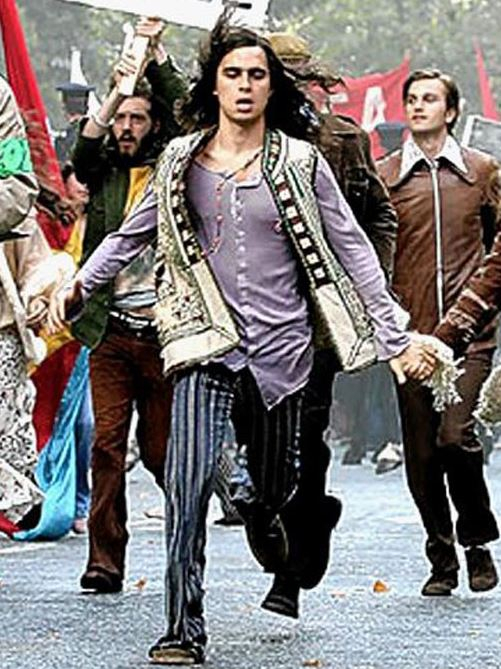
A hippie protester in Eastern inspired clothing during the Summer of Love.
The nuances and distinction seen in hippie men’s fashion, however, never gained traction among designers as it did among women’s fashion. Instead, they popularized pants in bright colors, slimmer fashion-oriented work shirts, corduroy, “jean jackets,” men’s sandals, and bohemian men’s jewelry.
“Distressed” clothing, particularly shirts, grew popular enough for acid washing to occur with chambrays and other more rugged men’s clothing.
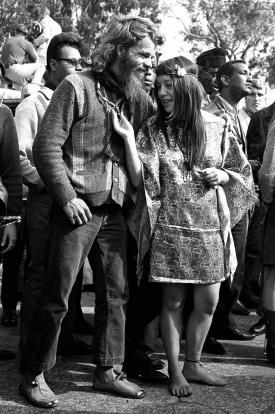
1967 man wears dark denim jeans and a cardigan sweater like –>
Bell-bottom jeans and trucker jackets grew popular in lighter denim washes, and denim-on-denim also became fashionable. When the ’70s arrived, flared trousers became popular with both men’s casual and business attire.
- 1967 Chevron and stripe earth tone sweaters and cardigans
While men’s hair was kept short and neat in the early years of the hippie movement, men’s hair and beards grew long and unmaintained towards the end of the 1960s. Full beards, sideburns, and mustaches with a shaved chin made a regular appearance.
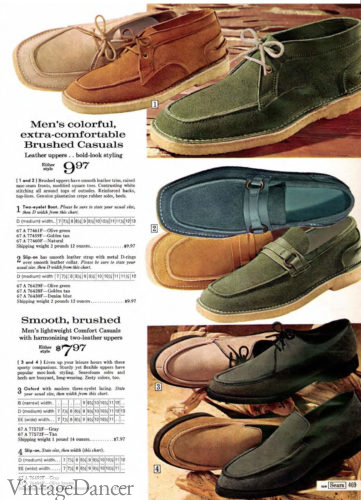
1969 brushed suede mocs, loafers, oxfords
It’s in the details – some notes on styling:
- Black shoes, particularly shiny black shoes, were seen as “cop shoes” by most hippie men. Choose shoes with roughout leather or a weathered patina such as suede moccasins, loafers, and boots. Shop shoes.
- Men’s straight-leg trousers were worn at flood length. You can easily achieve this by ordering a shorter inseam or through hemming services. Ideally, the hem should either hit at the ankle or fall 1-2” above the foot. Make sure your trousers sit at or above your waist. Shop trousers.
- The Type III denim jacket, AKA trucker jacket, was released in 1967. It caught on quickly with hippies in the late ’60s, but for earlier looks a canvas jacket or A-2 bomber is the best outerwear. Shop jackets.
- Shorts of the 1960s went up to about mid-thigh. Look for shorts with a 5″-6″ inseam for the most ’60s look, and pay attention to the high rise. Even in summer, most men wore trousers.
- Tee shirts in the 1960s, especially the early-mid ’60s, were cut differently than those of today. Most notably, they were tighter with quarter sleeves. If you’re going for a basic hippie look, keep it retro with shorter sleeves and a shorter hem as well. I’m fond of Mister Freedom’s Stanley Tee shirt for its solid construction and slubbed fabric. Shop tees, polos, and button downs.
- Accessories such as headbands, pendant necklaces, wide belts, round sunglasses, bandannas, and cowboy hats will help complete the hippie look.
- Joe Crocker performs at Woodstock 1969 in a tie dyed henley shirt and vertical striped pants.
- 1967 – a man’s choice and decoration of his hat was the easiest way to stand out.
- An American flag bandanna, tie dye shirt, tie dye stockings, moccasin boots, “bug-man” aviators, and a cropped vest doesn’t turn heads at Woodstock 1969.
- George Harrison and Pattie Boyd-Harrison
Debbie Sessions has been teaching fashion history and helping people dress for vintage themed events since 2009. She has turned a hobby into VintageDancer.com with hundreds of well researched articles and hand picked links to vintage inspired clothing online. She aims to make dressing accurately (or not) an affordable option for all. Oh, and she dances too.
